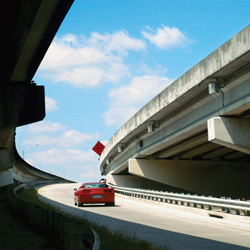Regional Transportation

With the recent debate and subsequent passage of the American Recovery and Reinvestment Act of 2009 (ARRA), much attention has been paid to the immediate needs of our transportation system. Indeed, the needs are great, as most analyses of the health of our nation’s transportation infrastructure are relatively grim. As essential as transportation is to the economic, social and community health of our society, this bill is a welcomed step in improving our transportation system, as it will bring approximately $40 million in new transportation funding to our region.
The vast majority of this funding will be used for maintenance and repair of existing roadways. While some would undoubtedly like to see more of this funding utilized for new roads and transportation infrastructure, many jurisdictions have little choice but to use it to repair existing roads. This is primarily due to two factors: an ever-growing network of roads, and a persistent and growing shortfall of maintenance funding. Combined, these trends have created an unsustainable situation where we can’t afford (at current taxing rates) to keep our existing transportation systems well-maintained, let alone add new roads, transit lines and trails that must also be maintained. So beyond the intended benefits, ARRA has also highlighted the unsustainable nature of the way we have developed, maintained and funded our transportation network.
In order to address this tenuous situation, our region, state and nation will have to ask and answer a series of difficult questions. What will our transportation system look like in 20 years? What should it look like? What changes need to be made to make the system safer, more efficient, more inclusive and more environmentally responsible? Given severe funding constraints, what changes can be made?
Over the next year, the Tri-County Regional Planning Commission will seek to address these difficult questions as we facilitate the creation of a new Long-Range Transportation Plan (LRTP) for the region. The Commission and its transportation planning arm, the Peoria-Pekin Urbanized Area Transportation Study, are required to update the LRTP every five years, but the importance goes far beyond simply meeting a federal requirement. The LRTP is our opportunity to establish transportation-related goals for the region and develop a consensus on how best to achieve those goals.
This process is needed now more than ever. The previous LRTP was written in 2004, and in the ensuing five years, transportation has seen significant changes:
- Rising and volatile fuel costs have resulted in a decrease in the number of miles driven, significant increases in mass transit (both bus and rail), bicycling, and pedestrian trips, and a shift towards smaller vehicles and more fuel-efficient technologies.
- Increasing recognition that where and how we upgrade our transportation system must be better coordinated with where and how we build our homes, businesses and community facilities (and vice versa) if we want to improve safety, reduce congestion, improve public health and promote a positive quality of life.
- Growing acceptance that environmental planning must be conducted in conjunction with transportation planning in order to minimize the air, water and noise pollution from transportation activities.
- Continued significance of freight transportation and related economic development, with mounting need for capitalizing on the more fuel-efficient rail and barge sectors.
These issues, among others, will be highlighted and discussed during meetings and hearings over the next year. We will be seeking input from stakeholders in business, government, neighborhoods and the general public. The response received from all segments of the community will be weighed and packaged into a new LRTP that represents a coordinated, consistent vision for our region’s transportation system.
The new LRTP will go beyond just a broad strategic vision, however. It will also identify specific transportation infrastructure projects our region and our individual communities will seek to have built. These projects may have been identified for any number of reasons, including safety, economic development, efficiency, congestion mitigation, and/or environmental restoration, but all will be important components of our transportation future.
The American Recovery and Reinvestment Act has spurred the nation and our region to look closely at our immediate transportation needs, and it has provided some funding to make short-term improvements. However, the issues facing our transportation system simply cannot be addressed by short-term solutions. Our communities and our region require an analysis of transportation patterns and infrastructure investments with a much longer-term horizon. The Long-Range Transportation Plan will aid that analysis by laying out a vision for how and where we build transportation infrastructure that supports our region sustainably. iBi

